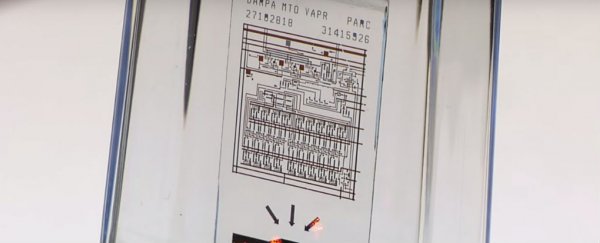Is it just me, or do you guys have an overwhelming desire to drop everything and become a spy all of a sudden? Developed by California-based tech company, PARC, in partnership with the US Defense Advanced Research Projects Agency (DARPA), this new self-destructing computer chip will shatter into so many thousands of tiny pieces on command that whatever was on it will be impossible to recover.
"The applications we are interested in are data security and things like that," PARC senior scientist Gregory Whiting announced at the Wait, What? A Future Technology Forum, hosted by DARPA in St Louis last week. "We really wanted to come up with a system that was very rapid and compatible with commercial electronics."
The chip is made from Gorilla Glass - a specialised material that's used widely in smartphone screens, portable computer displays, and some television screens, because of its high surface strength, crack-resistence, and ability to withstand heat stress and pressure. The sheet glass is reinforced by being immersed in a potassium salt ion-exchange bath heated up to about 400 degrees Celsius.
This forces large sodium ions to be 'stuffed' into the glass surface, forcing out the smaller ones, which creates a state of compression on the surface of the glass. "This layer of compression creates the surface that is more resistant to damage," the manufacturers explain.
The researchers at PARC then messed with the ion composition of the Gorilla Glass further so it would shatter in a particlar way under extreme stress. "We take the glass and we ion-exchange temper it to build in stress," said Whiting. "What you get is glass that, because it's heavily stressed, breaks it fragments into tiny little pieces."
Martyn Williams explains how it works over at PC World:
"In a demonstration on Thursday, the glass was stressed to breaking point by heat. When a circuit was switched on, a small resistor heated up and the glass shattered into thousands of pieces. Even after it broke up, stress remained in the fragments and they continued breaking into even smaller pieces for tens of seconds afterwards."
Williams reports that the self-destruct mechanism was triggered by a semiconductor device called a photodiode, which kick-started a circuit when exposed to a bright laser light. But the team behind the technology say the reaction could be triggered by a whole range of things, such as a tiny mechanical switch, or a radio signal, if you want to cover your tracks more remotely.
The most obvious use for the technology right now would be for protecting high-security encryption codes used by government defence agencies, but as Andrew Liszewski points out at Gizmodo, maybe one day we'll have access to it in the form of smartphones that can self-destruct when lost or stolen. Gotta protect all those photos of your cat from getting into the wrong hands, am I right?
